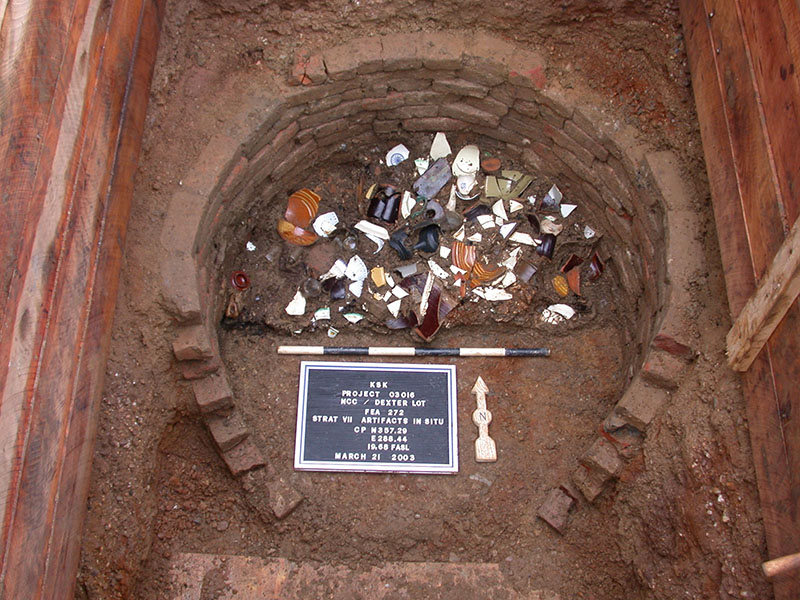Privies, Puzzles, and Pots: The Archaeology of Philadelphia Ceramics
Click on images to enlarge them and view captions.
by Deborah Miller
As an archaeologist I am often asked if I like to do puzzles because I am an expert at putting broken objects back together. The answer is no, I don’t like puzzles. But what I do enjoy is helping an artifact that has been in the ground—in some cases, literally in the toilet—for hundreds of years return to form and share its history. This is especially true of ceramics, not only because they are beautiful things that illustrate where we are in time, but also because, like other artifacts, they are the physical remains of the past human experience. They are a direct connection to the people who used them and to the ideas and behaviors that dictated why they were made, how they were made, and who was intended to use them.
Most archaeologists spend their careers studying small sherds (not shards!) that represent only a fraction of the vessel from which they came. Yet, at Independence National Historical Park (INHP) in Philadelphia, where we care for almost two million archaeological artifacts, we are a bit spoiled because our artifacts are most often recovered from privies (figure 1). Privy deposits differ from most archaeological sites because, in addition to being a toilet, they were also the trash receptacles of their day. If a ceramic plate was broken, most of the pieces were swept up and discarded into the privy pit. Multiply that trash by a century or more of time, along with the many families who could have lived at that site over that timeframe, and you have a lot of trash. This practice results in a high rate of reconstruction for ceramic and glass artifacts, which, when compared to many other sites, is truly an embarrassment of riches. I was thrilled to share some of my findings with Decorative Arts Trust members during their Spring Symposium, in a lecture, a tour, and an object study.
The ceramics we encounter through archaeology at INHP span the entirety of Philadelphia’s history, from those left behind by the Lenape before the arrival of Europeans to 20th-century sanitary wares made nearby in Trenton, NJ. Most, however, date to the late-18th through the mid-19th centuries and come from all over the world. Our archaeological collections abound with Chinese porcelain; German stoneware; French, Dutch and Portuguese tin-glazed earthenware; and many, many others. The American wares, specifically those made in Philadelphia, are striking because they not only represent early American industry but are also illustrative of the cultural melting pot that was early Philadelphia.
The first potters arrived in Philadelphia in the late 17th century not long after the Province of Pennsylvania was established in 1681. By 1720, red-bodied earthenware was being produced by at least five potteries, and a pottery operated by the Duchè family made both stoneware and earthenware (figure 2). This growth progressed into the mid-18th century, when slip-decorated earthenware, now known as the Philadelphia Style, became recognized across the colonies for its quality and durability. Archaeology has demonstrated that Philadelphia slipware (figure 3) had eclipsed similar imported ceramics, specifically Staffordshire-style slipwares, by the 1740s and dominated the local marketplace. Some Philadelphia potters, including Michael Hillegas and Richard Standley, were exporting their wares as early as the 1730s to other colonies and as far afield as the West Indies.
As the 18th-century progressed, so did Philadelphia’s ceramic industry. While potters still made tens of thousands of utilitarian red earthenwares each year, some also began experimenting with more refined clays and forms. Although few examples have survived above ground, archaeological examples are fairly abundant and speak to the skill, creativity, and business acumen of these potters. There are many examples of red earthenware mimicking clouded and/or tortoiseshell wares in a variety of forms from saucers to coffeepots. The red or buff colored clay body could be easily concealed beneath a white slip and various oxide glazes that bore a striking resemblance to their English counterparts when mixed.
Philadelphia’s experimentation with porcelain, however, had the most profound effect on early American ceramic manufacturing. From archaeology we now know that true, hard-paste porcelain was being made in Philadelphia just before Gousse Bonnin and George Anthony Morris established their Southwark factory in 1771. These earlier porcelains (figure 4) are virtually identical to English white salt-glazed stoneware, which makes them difficult to identify. The manufacturing source is unknown but was perhaps a joint effort between various potters, including Andrew Duchè, who returned to Philadelphia in 1769 following his porcelain-making adventures in the Carolinas. He may have had a hand in establishing the Bonnin and Morris operation, although no evidence has been found to support this theory.
In under a century, Philadelphia went from a fledgling town with small, artisanal crafts being made to support the infant colony to a colonial manufacturing powerhouse. By the time of the American Revolution, local potteries had produced hundreds of thousands of simple yet useful wares made from the abundant clays and minerals found in Philadelphia and her immediate hinterlands. They had also introduced experimental wares in earthenware, stoneware, and porcelain that would go on to change the face of American ceramic manufacturing in the 19th century and beyond.
Deborah Miller is the Assistant Curator at Independence National Historical Park.
A print version of this article was published in The Magazine of the Decorative Arts Trust, one of our most popular member benefits. Join today!




